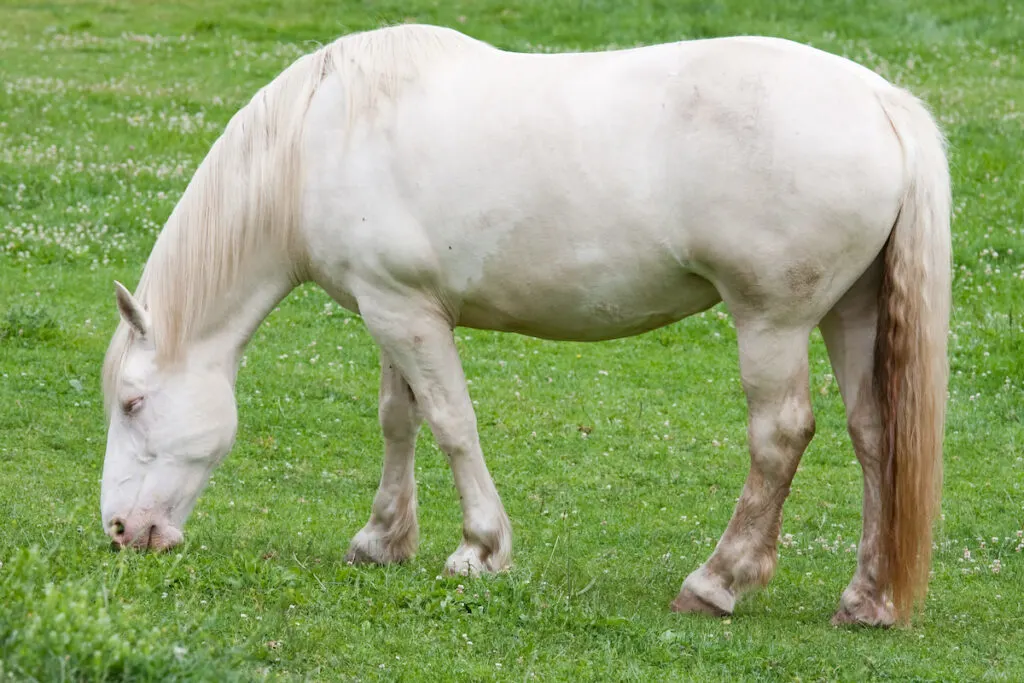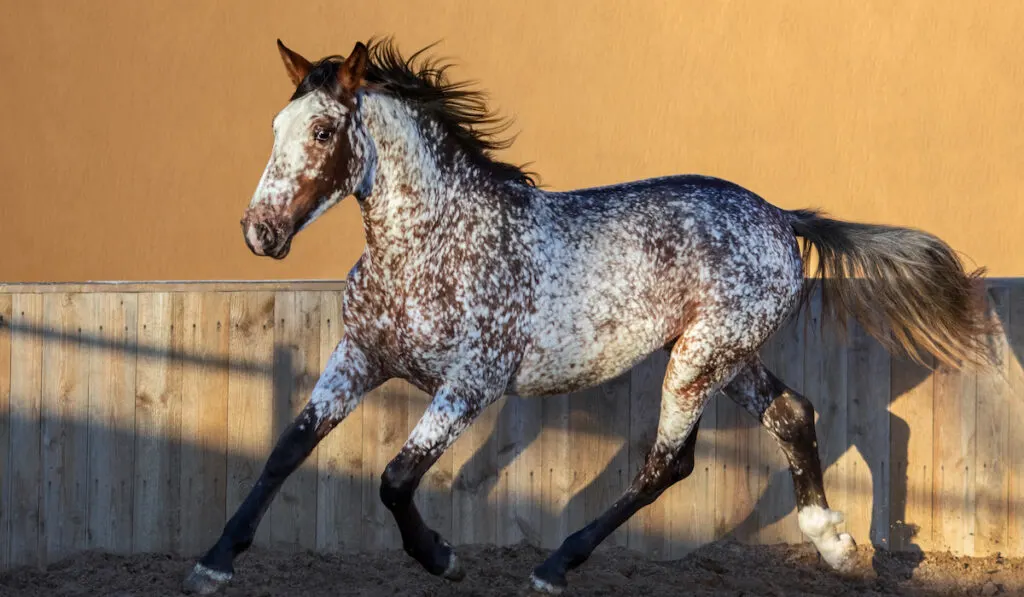When we talk about white horses, the first image that crosses our mind is often a knight in shining armor. Anyone who rides these horses would radiate an air of elegance and heroism.
Even in ancient times, white horses symbolized a connection between the earth and the spirit world.
Some of the white horses that are being commercially used today are draft horses. These horses are not biologically white. In fact, their coats are either in cream or gray color and become lighter in color when they mature.
With that said, we are going to take a deep look at these 11 white draft horse breeds that would definitely catch your eye:
Table of Contents
1. The Percheron
Percherons are magnificent draft horses that have been primarily used in war and other heavy-duty work. This breed was developed in the Perche province in Normandy, France. They were the result of crossbreeding between Barb horses and Flemish draft breeds with Arabians.
These horses come in different colors like white, cream, black, bay, roan, and sorrel. Some white markings can also be found on the head and feet.
Percherons generally stand between 15 and 19 hands high. They have muscular and sturdy bodies with powerful legs, thick manes, and tails.
Although they are larger than other breeds, these horses are friendly and forgiving to beginners. People who are new to riding can opt for this breed.
These horses are also easy to train and get along well with humans. Today, Percheron horses are mostly used in pleasure riding, trekking, show rings, and other equine sports.

2. The Camargue
Considered as one of the oldest horse breeds in the world, the Camargues have been living in the Camargue marshes and wetlands in the south of France for thousands of years.
They are also called the ‘Horses of The Sea’ due to their agility, hardiness, and stamina. These horses were often used on farms and ridden by the cowboys of the Camargue.
The Camargues generally stand between 13 and 14 hands high. When they are first born, their coats are dark brown or black in color. As they mature, the coat will turn white or grayish. They also possess square heads, sturdy bodies, muscular legs, thick manes, and tails.
Today, they are used in different activities like pleasure and endurance riding, dressage, and livestock management, as well as other equine sports. Due to their calm and intelligent nature, the Camargues are fairly easy to handle.
3. The Boulonnais
Also known as the ‘White Marble Horse’, The Boulonnais are French draft horses that were developed by mixing other horse breeds like the Andalusian, Mecklenburg, Arabian, and Spanish Barb.
These horses are native to the Bologne District of France and were used for heavy draft work in farms, ranches, and cities.
In the early 1900s, they were imported to the United States in large numbers, but World War I and II significantly reduced their population. Today, they are being preserved as an endangered species and bred by only a few experienced horse handlers.
The Boulonnais generally stand between 15.1 and 16.3 hands high and come in different colors like white, gray, bay, and black. The most common colors in today’s generation are white and gray due to the decline of most Boulonnais horses with black and bay genes.
These horses possess short heads, wide foreheads, muscular bodies, thick manes and tails, and powerful legs. Nowadays, they are being used in show rings, dressage, farm work, and pulling carriages.

4. The American Cream Draft
The American Cream draft horses originated in Iowa in the 1900s. Being one of the rarest draft breeds in the United States, they came from one cream-colored draft mare named Old Granny. These medium to large-sized horses stand between 15 and 16.3 hands high.
Back then, the American Cream drafts were used for draft work on the farms. Today, they are used for leisure riding, pulling carriages, as well as other ranch work.
These horses can be recognized by their athletic bodies, thick and muscular neck, and strong legs. Their calm and easy-going temperament make them easy to be trained and handled.
Also, their willingness to work is one of the contributing factors as to why people choose the American Cream drafts as workhorses on their small farms.

5. The Thoroughbred
The origin of the Thoroughbred horses can be traced back to the late 17th century when the horse racing industry became one of the booming industries in the United Kingdom. This breed was developed from the offspring of the three foundation imported stallions: the Darley Arabian, the Godolphin Arabian, and the Byerly Turk.
They first arrived in the United States in 1730 and gained popularity in the horse racing industry in Kentucky and Tennessee. Today, aside from horse racing, they are also used in dressage, show rings, as well as other equine sports.
Thoroughbreds generally stand between 15 and 17 hands high. Their coat mostly comes in different solid colors like whitish cream, gray, brown, bay, chestnut, and black.
They also have a sturdy figure, long neck, and powerful hindquarters that contribute to their speed and athletic ability. These horses can run up to 40 miles per hour with grace and agility.
6. The Orlov Trotter
The Orlov trotters are one of the finest and oldest horse breeds from Russia.
This breed was developed by Count Alexei Orlov in the late 18th century by mixing a few different breeds such as the Friesian, the Andalusian, the Mecklenburger, the Danish, and the Dutch.
These horses were primarily used in agricultural and draft work, racetrack, and pleasure riding.
The Orlovs generally stand between 15.2 and 17 hands high. Being slightly larger and other trotter breeds, they have large heads, long necks, muscular bodies, and hindquarters. They also come in different colors like whitish gray, black, bay, and chestnut.
Due to their distinctive and fast trotting gait, the Orlovs are favored by most farmers and horse owners for heavy work.
They are also a hardy breed that can withstand extreme climates and harsh terrains.

7. The Appaloosa
The Appaloosas are well-known for the spotted pattern found on their coats.
This breed was originally known as the ‘Palouse horses’ to reflect the Palouse river in the Northwestern United States where they were first developed. During the European colonization of North America in the 1700s, these horses were developed there by the Nez Perce tribe.
Then, in the 1870s, as Native Americans were losing their lands, most of these horses were stolen and killed. Preventive measures were taken in the 1930s to save this breed and finally, the Appaloosa Horse Club was found in 1938.
Appaloosas can be recognized by their spotted coats that come in different base colors like cream, chestnut, black, brown, bay, roan, dun, gray, palomino, and many more. There are also some patterns like stripes, blazes, and snips that can be found on their face.
The Appaloosa generally stand between 14 and 15 hands high.
Nowadays, they are mostly used for leisure riding, long-distance trail riding, horse racing, rodeo events, and other equine sports.
8. The Clydesdale
Originating in Clydesdale, Scotland, these horses are the pride of the Scottish nation. They were developed by crossing Lanarkshire (the former name for the Clydesdale district) native horses with Flemish stallions.
These horses were first brought to the United States in the late 1880s and used for heavy-duty tasks like pulling wagons, plowing fields, and other farm work.
The Clydesdale generally stands between 16 and 18 hands high with coats that come in different colors like cream, bay, black, chestnut, and brown. One of the interesting features that can be found on these horses is the light-colored, heavy feathering on their legs.
They are also larger than other draft breeds with muscular bodies, powerful legs, and large hooves.
Due to their thick manes, tails, and featherings, these horses should be groomed frequently to keep their coat healthy.
But most importantly, they are suitable for beginners that need calm, easy-going, and trainable horses that can obey their commands quickly.

9. The Shagya Arabian
The Shagya Arabian horses are native to Hungary and well-known in the Austro-Hungarian Empire.
This breed was developed by the ruler of this empire, Emperor Joseph II, as he aimed to develop superior cavalry horses by crossing desert-bred Arabian stallions and native Hungarian mares with other breeds like the Thoroughbreds, the Spanish horses, and the Lipizzaners.
These horses were then used as all-purpose horses due to their agility, endurance, strength, and speed. The name Shagya also originated from a Bedoin stallion born in 1830.
The Shagya Arabians generally stand between 15 and 16 hands high. They come in different colors like cream, gray, black, and chestnut. With their sturdy prominent head, muscular neck, sturdy figure, and strong legs, these horses are recognized as one of the best endurance horses.
For this reason, they are widely used today in different activities such as dressage, horse jumping, racing, as well as leisure riding. The Shagya Arabians are also calm, intelligent, and easy to handle.
10. The Camarillo White Horse
As one of the rarest horse breeds in the United States, the Camarillo white horses were developed in the early 20th century.
Their origin can be traced back to one foundation Spanish mustang named ‘Sultan’. Sultan, also known as the ‘Stallion of a dream’ was used to breed with Morgan mares to produce a pure white coat horse in the Camarillo ranch in California.
Unlike other horse breeds that appear creamish or gray, this breed is born white due to a specific gene mutation that prevents the formation of color on the coat. They don’t have other coat colors besides white.
The Camarillo White horses generally stand between 14.2 and 17 hands high. Physically, they have medium-sized heads with prominent eyes, well-arched necks, sturdy bodies, and strong legs.
Due to their majestic look, these horses are mainly used in parades and became the official horse of the city of Camarillo. It is estimated that there are less than 30 of these horses in the world.

11. The Lipizzan
The Lipizzaners’ origin can be traced to the 16th century where they were developed by the Habsburg Monarchy in Slovenia.
Being one of the oldest horse breeds in Europe, this breed was the result of crossbreeding between the Spanish Barb, the Arabian, and the native Karst horses, with other breeds that were already extinct like the Neapolitan horse, the Frederiksborg, the Kladruber, and baroque horses with Spanish bloodlines.
These horses generally stand between 14.2 and 15.2 hands high. They can be recognized by their long and flat-shaped heads, well-arched necks, sturdy bodies, and muscular legs. The Lipizzaners are born black or dark brown and turn gray to whitish cream when they mature.
Back in the old days, they were primarily used for riding and driving due to their athletic figure and agility. Today, these horses take part in other activities like dressage and other modern equine sports.
Their population is estimated to be less than 3,000 worldwide. Hence, they are also categorized as one of the rarest horse breeds.
Final Thoughts
Be it physical or just from aesthetical aspects, each of these white draft horses is unique in relation to how they were developed. Of all these 11 breeds, the only purebred white draft horse is the Camarillo White. Although other horses might appear to be gray or cream, they are still considered white horses.
Resources
The Percheron
- http://afs.okstate.edu/breeds/horses/percheron/index.html/
- https://www.thesprucepets.com/meet-the-percheron-horse-1886125
The Camargue
- https://www.horsebreedspictures.com/camargue-horse.asp
- https://www.globetrotting.com.au/horse-breed-camargue/
The Boulonnais
- http://www.theequinest.com/breeds/boulonnais/
- https://www.horsebreedspictures.com/boulonnais-horse.asp
The American Cream Draft
- http://afs.okstate.edu/breeds/horses/americancreamdraft/index.html/
- https://livestockconservancy.org/index.php/heritage/internal/americancream
The Thoroughbred
- http://afs.okstate.edu/breeds/horses/thoroughbred/index.html/
- https://www.thesprucepets.com/meet-the-thoroughbred-1886140
The Orlov Trotter
- https://www.globetrotting.com.au/horse-breed-orlov-trotter-2/
- http://afs.okstate.edu/breeds/horses/orlovtrotter/index.html/
The Appaloosa
- https://www.horseillustrated.com/the-appaloosa-horse-breed
- https://www.thesprucepets.com/meet-the-appaloosa-1886130
The Clydesdale
- http://afs.okstate.edu/breeds/horses/clydesdale/index.html/
- https://www.thesprucepets.com/meet-the-clydesdale-1886108
The Shagya Arabian
- https://www.globetrotting.com.au/horse-breed-shagya-arabian/
- https://www.horsebreedspictures.com/shagya-arabian-horse.asp
The Camarillo White Horse
- https://www.globetrotting.com.au/horse-breed-camarillo-white-horse/
- https://www.horsebreedspictures.com/camarillo-white-horse.asp
